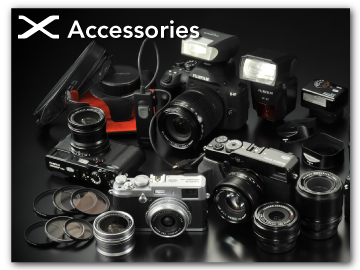Camera Displays
This section lists the indicators that may be displayed during shooting.
For illustrative purposes, displays are shown with all indicators lit.
- The Electronic Viewfinder
- The LCD Monitor
- Choosing a Display Mode
- Adjusting Display Brightness
- Display Rotation
- The [DISP/BACK] Button
- Customizing the Standard Display
- Virtual Horizon
The Electronic Viewfinder
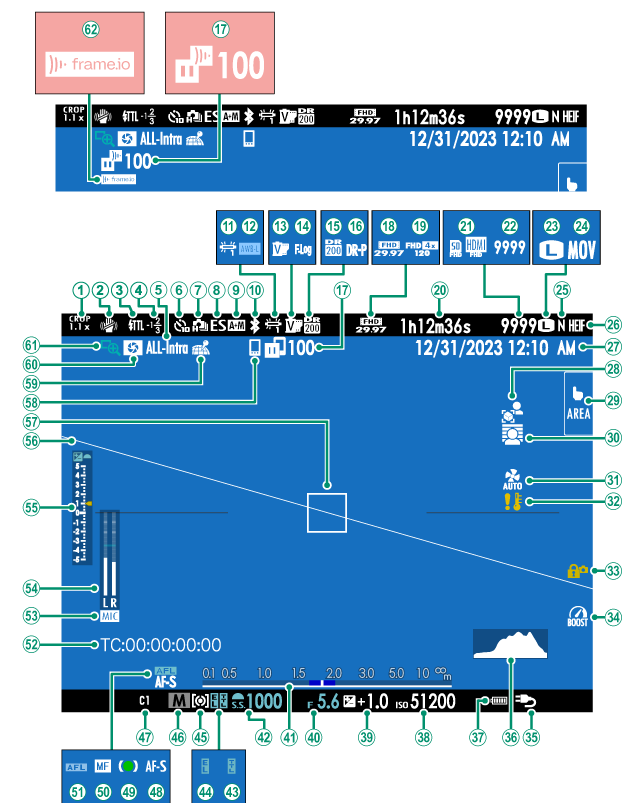
ACrop factor
BIS mode 2
CFlash (TTL) mode
DFlash compensation
EMovie compression
FSelf-timer indicator
GContinuous mode
HShutter type
IAF+MF indicator 2
JBluetooth ON/OFF
KWhite balance
LAWB lock
MFilm simulation
NF-Log/HLG recording
ODynamic range
PD-range priority
QImage transfer status 4
RMovie mode
SHigh-speed recording indicator
TRecording time available/elapsed recording time
UDestination for movie recording
VNumber of available frames 1
WImage size
XFile format
YImage quality
ZHEIF format
aDate and time
bProduct priority mode
cTouch screen mode
dBackground defocus mode
eCooling fan settings
fTemperature warning
gControl lock 3
hBoost mode
iPower supply
jHistogram
kBattery level
lSensitivity
mExposure compensation
nAperture
oDistance indicator 2
pShutter speed
qTTL lock
rAE lock
sMetering
tShooting mode
uCustom modes
vFocus mode 2
wFocus indicator 2
xManual focus indicator 2
yAF lock
zTime code
0Microphone input channel
1Recording level 2
2Exposure indicator
3Virtual horizon
4Focus frame
5Bluetooth host
6Location data download status
7Depth-of-field preview
8Focus check
9Connection status (Frame.io) 5
Shows “9999” if there is space for over 9999 frames.
Not displayed when [ON] is selected for D[SCREEN SET-UP] > [LARGE INDICATORS MODE(EVF)].
Displayed when controls have been locked by pressing and holding the [MENU/OK] button. Control lock can be ended by pressing and holding the [MENU/OK] button again.
The camera displays icons showing the status of files selected for or currently undergoing upload to Frame.io.
The camera displays an icon showing the status of the connection to Frame.io.
The LCD Monitor

ACrop factor
BLocation data download status
CFocus check
DDepth-of-field preview
EMovie compression
FImage transfer status 5
GBluetooth ON/OFF
HBluetooth host
IMovie mode
JHigh-speed recording indicator
KFocus frame
LRecording time available/elapsed recording time
MDate and time
NDestination for movie recording
ONumber of available frames 1
PBackground defocus mode
QImage size
RFile format
SImage quality
TProduct priority mode
UHEIF format
VCooling fan settings
WTouch screen mode 3
XAWB lock
YWhite balance
ZFilm simulation
aF-Log/HLG recording
bDynamic range
cD-range priority
dMovie optimized control 3
eVirtual horizon
fBoost mode
gTouch zoom 3
hTemperature warning
iControl lock 4
jBattery level
kPower supply
lSensitivity
mHistogram
nExposure compensation
oDistance indicator 2
pAperture
qTime code
rShutter speed
sTTL lock
tAE lock
uMetering
vShooting mode
wCustom modes
xFocus mode 2
yFocus indicator 2
zManual focus indicator 2
0AF lock
1Microphone input channel
2AF+MF indicator 2
3Shutter type
4Recording level 2
5Continuous mode
6Self-timer indicator
7Exposure indicator
8Flash (TTL) mode
9Flash compensation
-IS mode 2
^Connection status (Frame.io) 6
Shows “9999” if there is space for over 9999 frames.
Not displayed when [ON] is selected for D[SCREEN SET-UP] > [LARGE INDICATORS MODE(LCD)].
Camera functions can also be accessed via touch controls.
Displayed when controls have been locked by pressing and holding the [MENU/OK] button. Control lock can be ended by pressing and holding the [MENU/OK] button again.
The camera displays icons showing the status of files selected for or currently undergoing upload to Frame.io.
The camera displays an icon showing the status of the connection to Frame.io.
Choosing a Display Mode
Use D[SCREEN SET-UP] > [VIEW MODE SETTING] to choose from the following display modes. You can choose separate display modes for shooting and playback.
You can also assign [VIEW MODE SETTING] to a function button and use it to switch between the EVF and LCD monitor.
[SHOOTING]
| Option | Description |
|---|---|
| E[EYE SENSOR] | Putting your eye to the viewfinder turns the viewfinder on and the LCD monitor off; taking your eye away turns the viewfinder off and LCD monitor on. |
| [LCD ONLY] | LCD monitor on, viewfinder off. |
| [EVF ONLY] | Viewfinder on, LCD monitor off. |
| [EVF ONLY + ]E | Putting your eye to the viewfinder turns the viewfinder on; taking it away turns the viewfinder off. The LCD monitor remains off. |
| E[EYE SENSOR + LCD IMAGE DISP.] | Putting your eye to the viewfinder during shooting turns the viewfinder on, but the LCD monitor is used for the display of images once you remove your eye from the viewfinder after shooting. The options selected for D[SCREEN SET-UP] > [IMAGE DISP.]apply to display in the LCD monitor. |
Go to D[SCREEN SET-UP] > [VIEW MODE SETTING] in the setup menu and press the [Q] button to choose the view modes available.
[PLAYBACK]
| Option | Description |
|---|---|
| E[EYE SENSOR] | Putting your eye to the viewfinder turns the viewfinder on and the LCD monitor off; taking your eye away turns the viewfinder off and LCD monitor on. |
| [LCD ONLY] | LCD monitor on, viewfinder off. |
| [EVF ONLY] | Viewfinder on, LCD monitor off. |
The Eye Sensor
The eye sensor may respond to objects other than your eye or to light shining directly on the sensor.

Eye sensor
Adjusting Display Brightness
The brightness and saturation of the viewfinder and LCD monitor can be adjusted using the items in the D[SCREEN SET-UP] menu. Choose [EVF BRIGHTNESS] or [EVF COLOR] to adjust viewfinder brightness or saturation, [LCD BRIGHTNESS] or [LCD COLOR] to do the same for the LCD monitor.
Display Rotation
When [ON] is selected for D[SCREEN SET-UP] > [AUTOROTATE DISPLAYS], the indicators in the viewfinder and LCD monitor automatically rotate to match camera orientation.
The [DISP/BACK] Button
The [DISP/BACK] button controls the display of indicators in the viewfinder and LCD monitor.
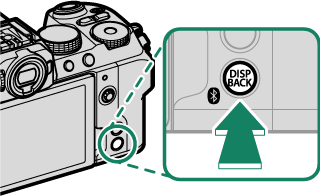
Indicators for the EVF and LCD must be selected separately. To choose the EVF display, place your eye to the viewfinder while using the [DISP/BACK] button.
Viewfinder
LCD Monitor
Customizing the Standard Display
To choose the items shown in the standard indicator display:
-
Display standard indicators.
Use the [DISP/BACK] button to display standard indicators.
-
Select [DISP. CUSTOM SETTING].
Select D[SCREEN SET-UP] > [DISP. CUSTOM SETTING] in the setup menu.
-
Choose items.
Highlight items and press [MENU/OK] to select or deselect.
Item Default [FRAMING GUIDELINE] R [FOCUS FRAME] R [FOCUS INDICATOR] R [AF DISTANCE INDICATOR] R [MF DISTANCE INDICATOR] R [HISTOGRAM] R [LIVE VIEW HIGHLIGHT ALERT] R [SHOOTING MODE] R [APERTURE/S-SPEED/ISO] R [INFORMATION BACKGROUND] R [Expo. Comp. (Digit)] R [Expo. Comp. (Scale)] R [FOCUS MODE] R [PHOTOMETRY] R [SHUTTER TYPE] R [FLASH] R [CONTINUOUS MODE] R Item Default [DUAL IS MODE] R [TOUCH SCREEN MODE] R [WHITE BALANCE] R [FILM SIMULATION] R [DYNAMIC RANGE] R [BOOST MODE] R [COOLING FAN SETTING] R [FRAMES REMAINING] R [IMAGE SIZE/QUALITY] R [MOVIE MODE & REC. TIME] R [COMMUNICATION STATUS] R [MIC LEVEL] R [GUIDANCE MESSAGE] R [NO MEMORY CARD WARNING] R [DATE/TIME] R [BATTERY LEVEL] R [FRAMING OUTLINE] R -
Press [DISP/BACK] to save changes.
-
Press [DISP/BACK] as needed to exit the menus and return to the shooting display.
Framing Outline
Enable [FRAMING OUTLINE] to make the borders of the frame easier to see against dark backgrounds.
Histograms
Histograms show the distribution of tones in the image. Brightness is shown by the horizontal axis, the number of pixels by the vertical axis.
|
Number of pixels
|
|
|
Shadows |
Pixel brightness |
|
Optimal exposure: Pixels are distributed in an even curve throughout the tone range.

Overexposed: Pixels are clustered on the right side of the graph.

Underexposed: Pixels are clustered on the left side of the graph.

To view separate RGB histograms and a display showing areas of the frame that will be overexposed at current settings superimposed on the view through the lens, press the function button to which [HISTOGRAM] is assigned (aFunction Controls).
AOverexposed areas blink
BRGB histograms
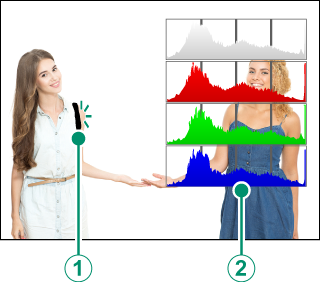
Virtual Horizon
Check whether the camera is level. The display type can be chosen using D[SCREEN SET-UP] > [ELECTRONIC LEVEL SETTING]. Use the virtual horizon to level the camera when mounting it on a tripod or the like.
2D

3D
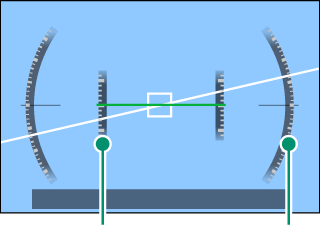
Pitch Roll
- [OFF]: The virtual horizon is not displayed.
- [2D]: A white line shows the amount the camera is tilted left or right. The line turns green when the camera is level. The line may vanish if the camera is tilted forward or back.
- [3D]: The display shows whether the camera is tilted left or right and forward or back.
[ELECTRONIC LEVEL SWITCH] can be assigned to a function button and the button then used to switch between the 2D and 3D displays.

 .
.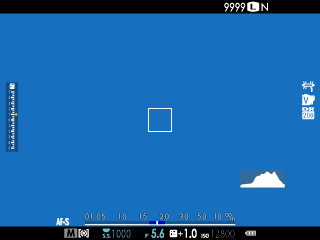



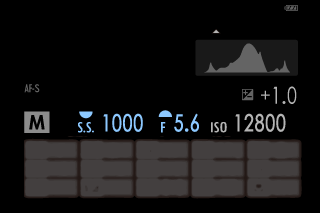



 Highlights
Highlights

